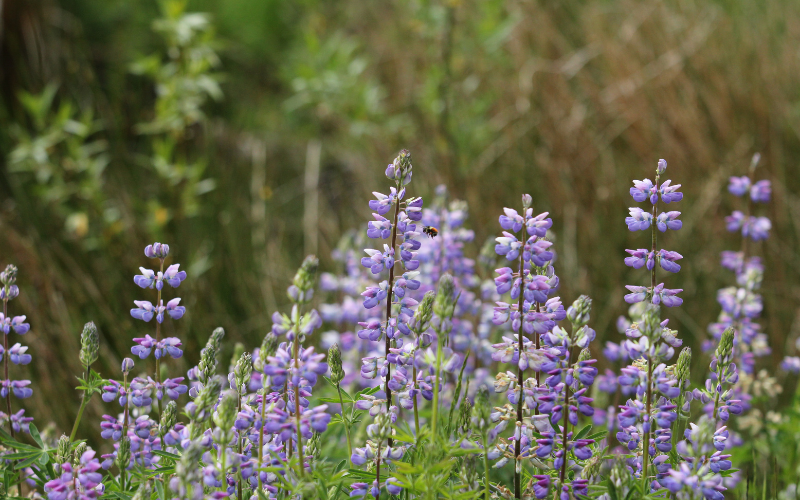
It’s National Pollinator Week 2023, and we’re excited to celebrate the variety of pollinators that populate our Oregon Coast ecosystems, from bees and butterflies to birds and even bats.
National Pollinator Week, which this year runs from June 19 to 25, is an annual celebration initiated and managed by the nonprofit Pollinator Partnership. According to the organization, it can be traced back 14 years, to when the U.S. Senate unanimously approved and designated a week in June as National Pollinator Week, marking “a necessary step toward addressing the urgent issue of declining pollinator populations.”
It has now grown into “an international celebration, promoting the valuable ecosystem services provided by bees, birds, butterflies, bats, beetles, moths, wasps, and flies,” states Pollinator Partnership.
For 2023, National Pollinator Week is highlighting the critical connection between pollinators and the climate. As the Pollinator Partnership website states:
“Pollinators are dying because their food and homes are disappearing, diseases have increased, and rising temperatures and natural disasters are affecting their ability to survive—all of which are related to climate change.”
“At the same time, the conservation of pollinators and their habitats can help combat climate change by supporting healthy ecosystems, air, soil, water, and plants. Combined, these results make planet earth a safer place for us to live. These are big problems, and the efforts that are made around North America and globally during Pollinator Week can help provide real solutions for the pollinators we all love.”
Individuals, organizations, and communities are encouraged to celebrate Pollinator Week in any way that’s fun, accessible, and fitting for them. Some popular events and activities include planting flowers and other native vegetation that attract pollinators; participating in bee and butterfly ID workshops; taking part in habitat restoration projects; hosting garden tours; or just learning more about pollinators in Oregon and the plants that attract them.


During Family Fun Day on June 17, we had a lot of help from young participants to make seed balls that will be used for habitat restoration.
Common Pollinator Plants on the Oregon Coast
There are numerous native plant and trees species that you can include in your garden to help attract pollinators. A few include lupine flowers, Douglas aster (Symphyotrichum subspicatum), prairie sage, common self-heal (Prunella vulgaris), Western spirea (Spirea douglasii), Pacific crabapple (Malus fusca), and camas, to name a very few. You can find a list of other great pollinator plants for Oregon here, as well as this list for 25 plants that attract native bees.
During North Coast Land Conservancy’s Family Fun Day on Saturday, June 17, a number of children helped our stewardship team create seed balls that will be used in habitat restoration on the northern Oregon Coast.
The seed balls are made with clay, soil and water, with the seeds embedded into the mixture. According to Land Steward Eric Owen, the stewardship team originally started using seed balls for plantings on the coastal prairie, a notably sandy and windy habitat that’s low in nutrients.
Putting the seeds within the balls of clay and soil offers them some nutrients and structure, and it helps keep the seeds protected from being eaten by bugs and birds before they have a chance to germinate, Eric says.
The seed balls made at the Family Fun Day included seeds for Douglas aster, tufted hairgrass, and self-heal. They will go to NCLC’s Shangrila Habitat Reserve in Seaside to revegetate the land, as they’re the “right species to augment that habitat,” Eric says.
You also can create seed balls to vegetate your yard or garden at home! Here’s a few tips:
- If you’re using a dry clay, the general recipe is two parts clay, two parts soil, and one part water. If using a wet clay that’s already been mixed, you’ll need less water.
- The key is the paying attention to consistency. You want the mixture to feel like cookie dough.
- Be careful where you collect the soil from, so it doesn’t include the seeds of invasive plants, grasses, or other things you don’t want in your garden or yard. We use an organic compost that’s been sterilized for our seed balls.
- You can mix the seeds into the soil, or if you want more precision, form the clay-soil balls and embed the number of seeds you want within each one.
- Let the balls completely dry out, which can take a couple of weeks.
- You can plant the seed balls in the fall, and then the seasonal rains will naturally dissolve the ball structure, allowing the seeds to germinate in the winter. Then, the plants will grow in the spring.
Happy Pollinator Week!
Comments